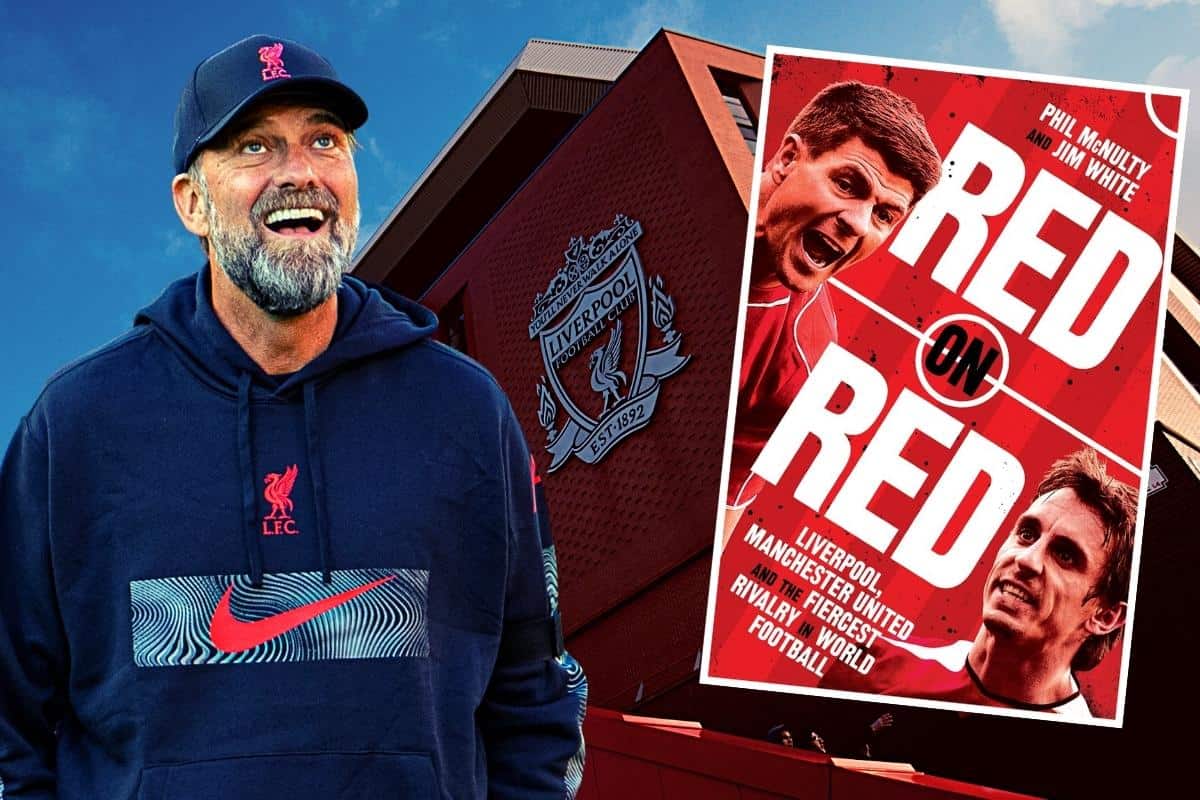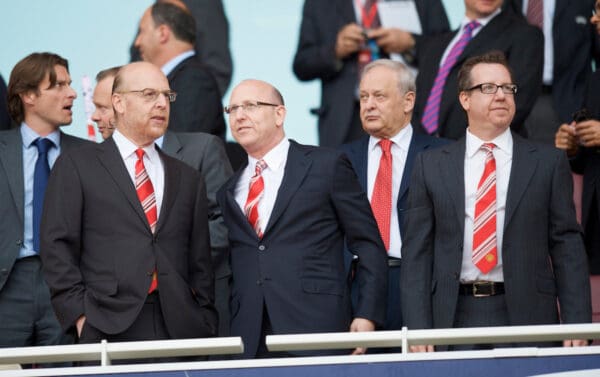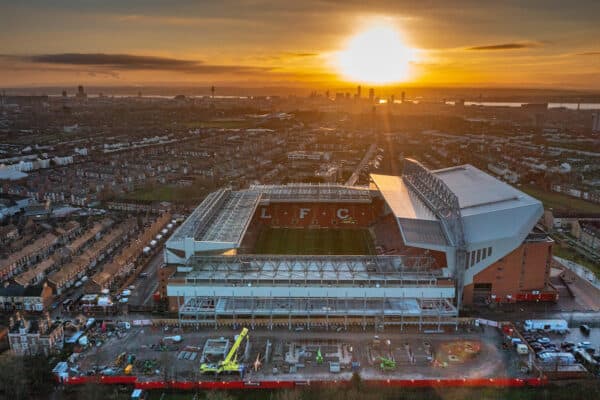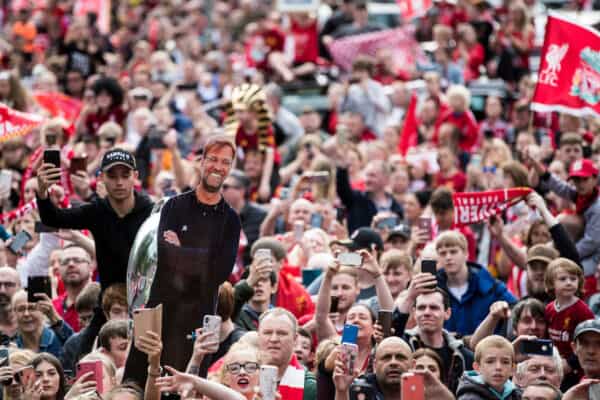
[ad_1]
After years of dominance in Manchester, there has been a power shift between Liverpool and Man United that has left the latter stuck in the 2000s.
For much of 2021 and 2022 if you tried to drive round Anfield, you wouldn’t have got very far. One of the roads around the stadium was blocked to traffic as construction work got underway on the latest stage of modernisation. By the first game of the 2022-23 season, a glittering new Anfield Road stand will lift the total capacity of the ground by 7,000 to 61,000. Following the extended main stand which opened for business in 2016, in just seven years, Liverpool will have increased the number of paying customers able to watch home matches by nearly 40 per cent.
Meanwhile at Old Trafford, as those gloating Scousers would not have failed to notice, there has been no new development since the quadrants were installed in 2006. In the autumn of 2021 the architects behind the magnificent new Tottenham Stadium were invited to submit their ideas for restructuring the Sir Bobby Charlton Stand to lift the capacity above 80,000. But at the time of writing, nothing concrete has been decided. When you walk round Manchester United’s historic ground you get the sense of a stadium that has been placed in a time warp, living on presumptions of perpetual greatness.
It is not just on the pitch that United have found themselves growing stale just as their despised red rivals accelerate. Off it too, Liverpool’s revenue has been playing a remarkable game of catch up.
In 2010, when the Fenway Sports Group rescued the club from the huckster ownership of George Gillett and Tom Hicks, Liverpool’s overall earnings were just 55% of United’s: £184million to £331million. By the 2020-21 season they were within touching distance: while United earned £643million, Liverpool turned over £619million. Once the new stand is in full operation, the Anfield ambition is to overtake United in football’s monetary league. This is a business with its foot to the floor.
How things have swung. Back in 2005, when Liverpool lifted the Champions League trophy for the fifth time in their history, Brendan Wyatt, the man behind the Transalpino store in the city’s Bold Street worked overnight printing “Five Times” t-shirts ready to sell to the thousands lining the route as the team bus undertook its triumphal procession round the city. Sell them he did: he had run out of stock soon after hitting the streets. Not that he had much in the way of official competition.
“The thing was,” Wyatt tells us, “the club didn’t have any memorabilia marking the win in their shop for three weeks. That was typical of them. Man United would have. Back then, they were way ahead of us with their corporate and merchandise department.”
Indeed through the Nineties and Noughties United mastered the connection between success and revenue, milking it for all it was worth. When the Glazer family took control of the club in 2005, by means of foisting a gigantic mortgage on the operation, they reckoned little needed to change, beyond encouraging the sales team to sell more. And such was the development of the infrastructure by the previous regime, they could sit in Florida cheerfully counting the dividends without any need for investment. They didn’t have to upgrade anything when they could sign up plenty of official Far Eastern mattress and pillow partners on the back of the club’s legend.

The problem was, the most significant legacy the Glazers inherited when they parked their debt on Old Trafford was reaching the end of the road. In his 26 years at the helm, Sir Alex Ferguson had knocked Liverpool off their perch, he had out-flanked Arsene Wenger, he had seen off Chelsea’s wealth, he had even wrested – albeit, as it transpired, temporarily – Mancunian superiority back from the noisy neighbours. But there was one rival he could never better: time.
Despite the evidence of his birth certificate his retirement found the Glazer operation about as prepared as a juggler who has just smeared their hands in butter. Their recruitment of replacements was laughable: in the time since he headed upstairs, they missed out on Pep Guardiola, Carlo Ancelotti, Thomas Tuchel, Antonio Conte, Jurgen Klopp, in fact most of the elite managers in Europe. Instead they paid way too much for those either not up to the job or well past their sell-by date. When Ferguson left office, first David Moyes, then Louis Van Gaal, then Jose Mourinho wilted in his long shadow, before Solskjaer came in promising a return to the good old days. They never came. When he was inevitably let go in the autumn of 2021 three weeks after presiding over that surrender against Liverpool (and this despite spending more than £400million on restructuring his team), United didn’t have a replacement sorted. They announced they would appoint a stand-in (Michael Carrick) until they could organise an interim manager (Ralf Rangnick) who would hold the fort up to the point they might be able to find a permanent boss. When Erik Ten Hag, the Ajax manager, was announced in the spring of 2022, he would not start work until that June, seven months after he should have been in place.
What a difference between the Glazer-inflicted stagnation at Old Trafford and the way John Henry and his Fenway Sports Group run Anfield. Bringing their knowledge of how to revive a sleeping giant of a sporting brand accrued from their ownership of the Boston Red Sox, they transformed everything. Not least the philosophy that held sway in the boardroom for years that Liverpool should be above the vulgar pursuit of cash. Under the stewardship of the FSG President Michael Gordons and CEO Billy Hogan, the operation was turbo-charged. Hicks and Gillett’s fanciful plans to rebuild the stadium were quickly transformed into workable solutions. Revenue streams were updated, commercial opportunities exploited, the money lurking in the fans pockets ruthlessly chased.

But clearly the most astute move by the new regime was in its managerial recruitment. FSG, in contrast to United complacency, learned from their mistakes. Their first appointment after they fired the disastrous Roy Hodgson in 2011 was to bring back the great Anfield hero Kenny Dalglish. The idea was to realign the club with its fanbase and he won the League Cup in his first season. But he messed up badly over Luis Suarez and when he was relieved of his duties a bright young manager in Brendan Rodgers was brought in. Encouraging intelligent, progressive football, in 2014 Rodgers took the club to within a Steven Gerrard slip of finally breaking their 24 year duck and winning the Premier League title. But when a better manager became available, Rodgers was moved on without sentiment or delay. Part of the upgrade. That’s what proper sporting organisations do: they employ better. And FSG are a proper sporting organisation.
For sure, Henry and his executives have made some woeful public relations missteps along the way. Trying to impose a £77 ticket price, looking to trademark the city’s Liverbird symbol (a move that Wyatt and a collective of other Liverpool traders stymied), hoping to piggyback on the government’s furlough scheme during the pandemic, not to mention the European Super League proposal: such rapidly ditched embarrassments were perhaps the inevitable outcome of the collision between ultra-capitalist owners and a hard core support than prides itself on socialist traditions. Nobody could argue, however, that the owners quickly recognised when they had got it wrong and changed tack.
If you want a measure of the scale of the booster they have injected into the Anfield revenue streams, it is there in the assumed value of the club. When the Americans bought Liverpool in 2010, admittedly from a beleaguered regime facing foreclosure from the banks seeking return on reckless debt, they paid £300million. In April 2021 the club was valued by Forbes at £2.96billion. That is what you call a return on investment.
But what really marks out their judgement is what they did when they moved Rodgers on. It is indicative of the difference between the operational expertise of the two organisations that, before Liverpool were in the market for him, United failed to persuade Klopp, the then Borussia Dortmund coach, to bring his tactical brilliance to Manchester as a potential replacement for Ferguson. It probably didn’t help that when he came to Old Trafford for talks, the self-congratulatory executive vice chairman Ed Woodward greeted a man who has long been known to be a stickler for footballing authenticity with the words “welcome to Disneyland”. By contrast, in a manner apparently beyond United’s executives, FSG easily persuaded Klopp to head to Anfield. This was a place, they told him, made for his values.

From the moment he arrived, alongside the director of football Michael Edwards, he invigorated every aspect of the club’s footballing side. It soon became clear as he went about his business that, while he may have been an outsider and not a Scouser, he understood the club and its place in the city. Pretty soon many began to believe that he was the closest thing they had had to Bill Shankly since the great man departed. Not least Chris Shankly Carline, Bill’s grandson, who opened a palatial Liverpool hotel named after his grandfather in 2016. And his opinion about the similarity probably carries rather more weight than most.
“When you look at Jurgen straight away, you say his biggest strength as a manager, above anything else, is his ability to make people warm to him,” says Shankly Carline when we meet him at the hotel that occupies the magnificent former Liverpool Post and Echo building in the city’s Victoria Street. “His players will run through brick walls for him. The camaraderie he generates in his teams is worth loads of points each season. It’s very similar to my grandad in that he created that atmosphere around the club. So it is with Jurgen. They also both recognise the role the fans play at the club and how close they are.”
This is an extract from ‘Red On Red’ by Phil McNulty and Jim White, published by HarperNorth on August 4. Purchase from Amazon here.
[ad_2]
Source link

